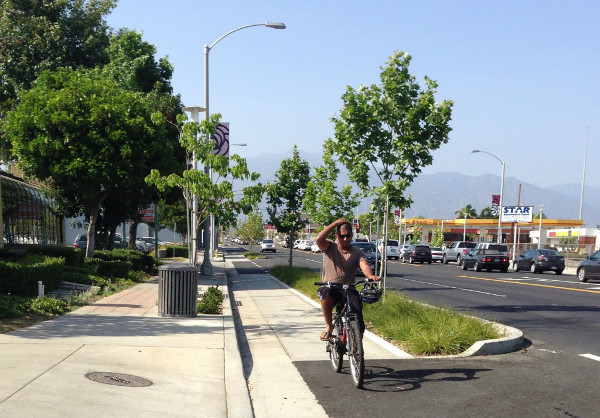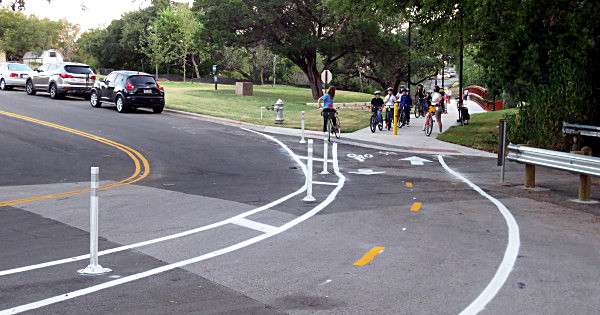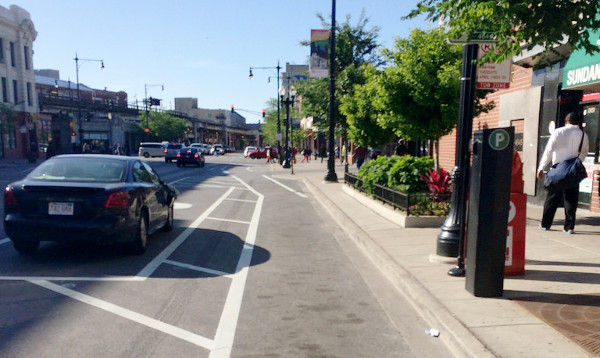For the second year, People For Bikes has named “America’s 10 Best New Bike Lanes.” These no-cars-allowed lanes help cyclists stay safe while traveling dense urban areas and suburbs. We love seeing these projects expanding in cities across the country.
1) Polk Street, San Francisco

Barely a third of a mile long, the Polk Street bike lane in San Francisco is painted green on each side of a one-way street and separated by curbs and a planter adorned with local cacti. The project is planned to extend down Polk Street.
2) 2nd Avenue, Seattle

Nine days before this protected lane project was to open, civil rights lawyer and new mom Sher Kung was killed by a left-turning truck while riding in the old painted lane. The bike-only signals that were about to be installed probably would have saved Kung’s life. This fall, a ghost bike sat at the corner of 2nd and University — as much a memorial to Kung’s life as the platoons of riders rolling, safely and comfortably, in the new protected lane.
3) Riverside Drive, Memphis

Instead of reopening all four lanes to auto traffic after Riverside’s annual closure for the Memphis in May festival, the city restriped half the street to create two lanes of car traffic, a bidirectional median-protected bike lane and a walkway. Soon, this route will be the best link between downtown Memphis and the new Harahan Bridge crossing to Arkansas.
4) Rosemead Boulevard, Temple City

Protected bike lanes passed a milestone in 2014: they made it to the burbs. In Virginia’s Arlington County, Maryland’s North Bethesda and here northeast of Los Angeles, street designers proved that protected lanes can be even more important in sprawling areas than they are in urban ones — especially when they’re as straight and as visible as Rosemead’s. This project, which opened in May, is already inspiring nearby Pasadena.
5) Furness Drive, Austin

A $1.2 million bridge crosses a creek that separates a relatively poor neighborhood from its local elementary school. City planners decided it would be a good idea to also think about the street between the bridge and the school. Eight months and $20,000 later, the city had used posts and paint along one side of an intersection-free road to create a safe and direct route to the school’s door.
6) Broadway, Seattle

Water-filled plastic loops combine with curbs, posts and parked cars to create a comfortable bikeway through the middle of one of Seattle’s densest commercial areas. Broadway uses signal phasing and lots of green paint to keep bikes both separated and visible.
7) SW Multnomah Boulevard, Portland

When storm drainage plans required rain gardens along this key route through a bike-unfriendly neighborhood, the city threw in another $2 million to build a few blocks of elevated bike lane, too. The result, which separates bikes and auto traffic by its curb and a parking lane, is an oasis of bike-friendliness in Southwest Portland — but if nearby Barbur Boulevard gets a mass transit line and protected bike lanes of its own as proposed, Multnomah will suddenly become an essential link to the rest of the city.
8) Penn Avenue, Pittsburgh

If Pittsburgh sticks with its plans, this rapidly executed project — announced in July, built by September — will become the spinal cord of a new on-street biking network that’ll link the city’s excellent riverside paths to commercial and cultural destinations downtown.
9) King Street, Honolulu

When this lane opened two weeks ago, the country quietly crossed a different milestone: Hawaii became the 26th U.S. state to get a protected bike lane. Temperate, flat and sunny, Honolulu could easily add “biking paradise” to its list of assets, and Mayor Kirk Caldwell seems dedicated to doing so. The bidirectional lane on King caught our eye for its length — two miles! — and its use of parking stops to create a nice temporary curb.
10) Broadway, Chicago

After Mayor Rahm Emanuel took office in 2011, his transportation team whirled into action, laying down 12 miles of protected bike lanes almost immediately. Three years later, Chicago is building protected lanes faster than almost any city in the country. Emanuel’s team added 3.25 miles in 2014, and a quarter-mile stretch of Broadway that offers one of the city’s few protected lanes through a busy commercial district.






